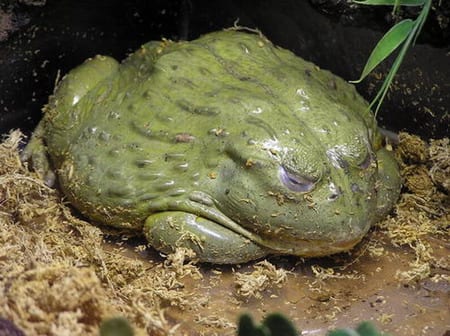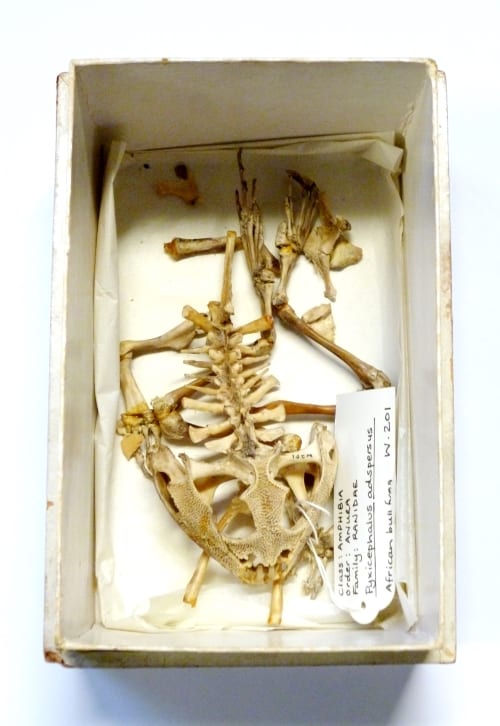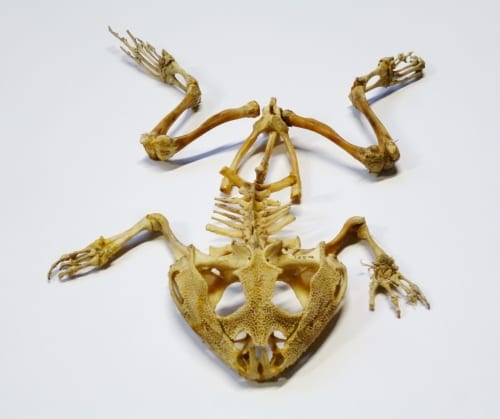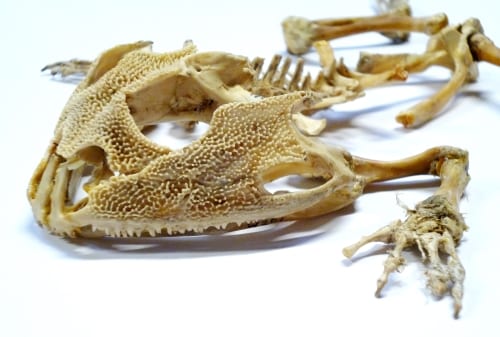Specimen of the Week 201: The African bullfrog
By Tannis Davidson, on 17 August 2015
This week’s Specimen of the Week was chosen from the thousands of possible contenders in a method designed to faciliate a more efficent decision-making process. Rather than highlighting a personal favourite or an unsung hero, the selection was left entirely to fate – regardless of the consequences. As it is Week 201 of this blog, why not (roll the dice) choose specimen W201 and see what happens? Will it be fluid or skeletal? Part or a whole? Cute or monstrous? As it turns out, W201 is all of these and more. This week’s Specimen of the Week is…
**The African bullfrog skeleton**
1. Fluid or skeletal
The first part of this week’s blog-writing process (after deciding upon the numerological doppelganger) was to look up the specimen record and see who/what belonged to that record. LDUCZ-W201 (as it is more properly known) is:
Full object description: “Partially articulated skeleton in box ”
Object category: “Fluid”
As exciting/alarming as the prospect of finding a skeleton preserved in spirit (in a box!) may be, it was, upon discovery, an incorrect object category entry*. Just a skellie in a box.
2. Part or whole
It appears that the whole skeleton is present. It is partially articulated meaning some of the component bones are attached to each other – in this case, with an unknown adhesive. Perhaps this specimen was once all together and has fallen apart (likely) or maybe only certain bits are articulated in effort to show the overall size of the animal or the shape of the entire leg (for example). W201’s skull and vertebrae are articulated as are the bones which make up the front and hind limbs. At the very least, this makes it quick and easy to arrange the skeleton to reveal its full anatomical glory:
3. Cute or monstrous
Skeletons are rarely described as being cute, but I wouldn’t consider W201 as being monstrous looking either. As skeletal remains go, it is quite clean and has no offensive odour. Yes, the left front foot resembles a long-dead hand of a mummy emerging from rotting bandages (what is that stuff?). And yes, the size of the frog itself is monstrous – the skull and body are 15cm long (not including legs). This species of bullfrog is one of the world’s largest reaching lengths of 24 cm (body) and weighing over 2 kg. As a long-dead museum specimen however, W201 is ‘pretty’ good.
4. Pixie or Pit bullfrog
The African bullfrog, Pyxicephalus adspersus, is also known as the ‘pixie’ frog due to the phoenetic similarity to its Latin name. As pixies are generally described in folklore as being small/wee/little, I can only guess that any association concerning the size of this frog has got to be ironic (unless it is literally the size of an actual pixie).
Pixies also have a reputation of being mischievous, but the behaviour of Pyxicephalus is less flippant, and more fiendish. Equipped with fang-like teeth, African bullfrogs are voracious carnivores eating insects, amphibians, reptiles and small birds. The males may be cannibalistic and eat the tadpoles they are guarding 1. More pit bull than pixie, African bullfrogs are aggressive and will bite (humans) when provoked.
5. Yay or nay?
To conclude this week’s Specimen of the Week adventure, I’d like to add that I think that the methodology used to choose the specimen was successful. Not normally drawn to amphibians, I enjoyed learning more about this one and was prompted to investigate others in the collection. As a result of this (subjective) anaylsis/(semi-scientific) investigation, we may conclude that W201 is more skeletal than fluid, more whole than part, and slightly less cute than monstrous. Although, in the flesh, Pyxicephalus adspersus is undeniably beastly…

African bullfrog Pyxicephalus adspersus. Photo by Grzegorz Polak (Creative Commons Attribution-Share Alike 3.0 Unported, GNU Free Documentation License Version 1.2)
Tannis Davidson is Curatorial Assistant at the Grant Museum of Zoology
References
1.Geens, Raymond, 2009. Bronberg: “African Bullfrog Haven”. Bronberg Newsletter. [online] http://www.chroniclesa.co.za/index.php/conservancies/533-bronberg-african-bullfrog-haven (accessed 14 August 2015)
* Now rectified to its precise categorical reality: “Skeleton”
One Response to “Specimen of the Week 201: The African bullfrog”
- 1
 Close
Close






A beautiful specimen of an African Bullfrog and nicely photographed. You might want to address the section on pixies though as its name Pyxicephalus is Greek not Latin and refers to the shape of its head Pyxis being a circular box and cephalus meaning head. Unfortunately, nothing to do with mythical pixie sprites.